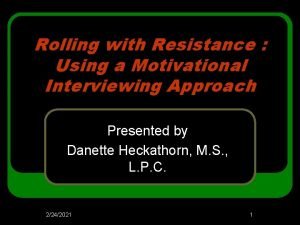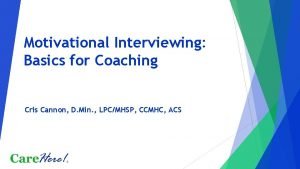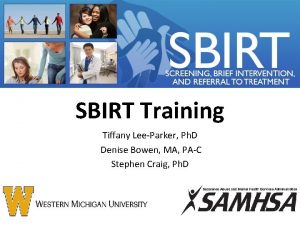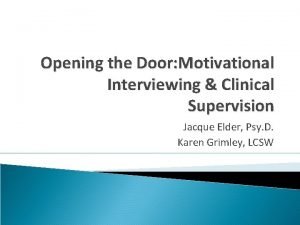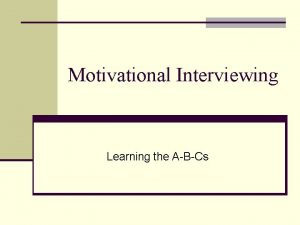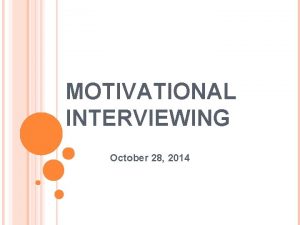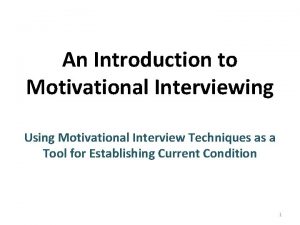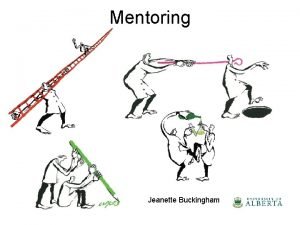Introduction to Motivational Interviewing Helping People Change Jeanette






























- Slides: 30

Introduction to Motivational Interviewing: Helping People Change Jeanette M. Tetrault, MD FACP FASAM Professor of Medicine Yale School of Medicine These slides were adapted with permission from Dr. Richard Saitz SLIDE

SLIDE 1

Persuade your partner • Pair off in a breakout room for 5 minutes • It is your partners job to get you to change • At 2 min and 30 seconds, switch SLIDE 2

What is motivation (or lack there of…)? SLIDE 3

Lack of motivation • A result of a confrontational counseling style • May be related to ambivalence, which is normal • Probability that a person will enter into, continue, and adhere to a specific change strategy • A state of readiness to change SLIDE 4

Enhanced motivation SLIDE 5

Ready, willing, and able OR willing, able, and ready? • Willing: express the IMPORTANCE of change • Able: CONFIDENT in ability to change • Ready: A matter of priorities… SLIDE 6

Assessing Importance and Confidence Low CONFIDENCE IMPORTANCE High Unwilling and Unable Willing but Unable Unwilling though Able Willing and Able High SLIDE 7

What do you do if your patient is willing AND able BUT NOT READY? SLIDE 8

Assessing Readiness to Change: A quick version • “On a scale from 1 to 10, how important is it for you right now to…. ? ” • “Why did you say a 5 and not a 0? ” • “What would it take to get you from a 5 to a 7? ” • “If you decide to change, how confident are you that you will succeed? ” • “You’ve decided to change, and you think you can succeed, what comes next? ” SLIDE 9

Motivational Interviewing A style of interacting with patients that addresses ambivalence and enhances the patient’s intrinsic motivation to change. S L I D E 10

Principles of Motivational Interviewing • Engage patient – Connect and understand patient – Provide empathy and affirmation • Focus – Explore goals and aspirations – Prioritize and agree on a topic for further exploration • Evoke – Center on patient’s own reasons for change – Develop discrepancy – Elicit change talk • Plan – Promote self-efficacy – Negotiate and assess confidence – Arrange follow-up S L I D E 11

Tools for effective Motivational Interviewing • Open-ended questions • Affirmations • Reflective listening • Summarize with purpose S L I D E 12

Tools for effective Motivational Interviewing • Open-ended questions Show curiosity Avoid yes/no answers • Affirmations Recognize effort Positive reframing • Reflective listening Simple: repeat or rephrase Complex: paraphrase or inferred emotion • Summarize with purpose Big, complex reflections S L I D E 13

Applying tools to Motivational Interviewing • Engage patient – Connect and understand patient – Provide empathy and affirmation Ask open ended questions • Focus – Explore goals and aspirations – Prioritize and agree on a topic for further exploration Use reflective listening Affirm patients feelings • Evoke – Center on patient’s own reasons for change – Develop discrepancy – Elicit change talk • Plan Summary statements – Promote self-efficacy – Negotiate and assess confidence – Arrange follow up S L I D E 14

Highlighting Components of Motivational Interviewing • Engage patient – Connect and understand patient – Provide empathy and affirmation • Focus – Explore goals and aspirations – Prioritize and agree on a topic for further exploration • Evoke – Center on patient’s own reasons for change – Develop discrepancy – Elicit change talk • Plan – Promote self-efficacy – Negotiate and assess confidence – Arrange follow up S L I D E 15

Highlighting Components of Motivational Interviewing • Engage patient – Connect and understand patient – Provide EMPATHY and affirmation • Focus – Explore goals and aspirations – Prioritize and agree on a topic for further exploration • Evoke – Center on patient’s own reasons for change – Develop discrepancy – Elicit change talk • Plan – Promote self-efficacy – Negotiate and assess confidence – Arrange follow up S L I D E 16

MI is rooted in empathy Empathy S L I D E 17

Let’s explore empathy…. RSA Short: Empathy by Dr. Brene Brown S L I D E 18

Highlighting Components of Motivational Interviewing • Engage patient – Connect and understand patient – Provide empathy and affirmation • Focus – Explore goals and aspirations – Prioritize and agree on a topic for further exploration • Evoke – Center on patient’s own reasons for change – DEVELOP DISCREPANCY – Elicit change talk • Plan – Promote self-efficacy – Negotiate and assess confidence – Arrange follow-up S L I D E 19

Developing discrepancy • Change is motivated by a perceived discrepancy between present behavior and important personal goals or values • The individual rather than the counselor or clinician should present the arguments for change S L I D E 20

Highlighting Components of Motivational Interviewing • Engage patient – Connect and understand patient – Provide empathy and affirmation • Focus – Explore goals and aspirations – Prioritize and agree on a topic for further exploration • Evoke – Center on patient’s own reasons for change – Develop discrepancy – Elicit CHANGE TALK • Plan – Promote self-efficacy – Negotiate and assess confidence – Arrange follow-up S L I D E 21

Change Talk: Self-motivating speech Disadvantage of status quo “I know my drinking is ruining my marriage” Optimism for change “I have stopped using cannabis before, I know I can do it again” Intention to change Advantage of change “Once the audit is done at work and I am less stressed, I will cut back on drinking” “If I stop using cocaine, I will be more focused at my job” S L I D E 22

DARN_C: Framework for looking for change talk • Desire for change • Ability to change • Reasons for change • Need to change • Commitment to change S L I D E 23

Highlighting Components of Motivational Interviewing • Engage patient – Connect and understand patient – Provide empathy and affirmation • Focus – Explore goals and aspirations – Prioritize and agree on a topic for further exploration • Evoke – Center on patient’s own reasons for change – Develop discrepancy – Elicit change talk • Plan – Promote SELF-EFFICACY – Negotiate and assess confidence – Arrange follow-up S L I D E 24

Self-efficacy • An individual’s belief in the possibility of change – Important motivator • The individual, not the clinician, is responsible for choosing and carrying out change • The clinician’s own belief in the individual’s ability to change becomes a self-fulfilling prophecy S L I D E 25

Roadmap of a Motivational Interview • Part I: Build Motivation for Change • Enhance alliance and autonomy • Part II: Negotiate Change and Strengthen Commitment • Provide information while creating dialogue START S L I D E 26

Brief Intervention vs. Motivational Interviewing Brief Intervention Motivational Interviewing Skill Simple, MI-informed Ask/assess Provide feedback with permission Higher level skill Engage Pros and cons Open ended questions with pros and cons (discrepancy) Focus Reflective listening Evoke Readiness to change Develop Discrepancy Elicit change talk Summary and key Question Plan Provide advice, arrange follow up Promote self-efficacy S L I D E 27

How do I teach this? • Integrate video / media – How do you have patient-centered conversations? Motivational Interviewing Basics. • Large group demonstration • Skills practice – Focus on teaching points: • Reflective Listening • OARS • Use real patient cases S L I D E 28

Thank you! SLIDE
 Ken kraybill
Ken kraybill Roll with the resistance
Roll with the resistance Motivational interviewing stages of change
Motivational interviewing stages of change Motivational interviewing
Motivational interviewing Dears motivational interviewing
Dears motivational interviewing Motivational interviewing schizophrenia
Motivational interviewing schizophrenia Cris cannon
Cris cannon Motivational interviewing dears
Motivational interviewing dears Ears motivational interviewing
Ears motivational interviewing German motivational speech
German motivational speech Motivational interviewing
Motivational interviewing Motivational interviewing
Motivational interviewing Readiness ruler motivational interviewing
Readiness ruler motivational interviewing Motivational interviewing
Motivational interviewing Change talk worksheet
Change talk worksheet Dares motivational interviewing
Dares motivational interviewing Stages of change social work
Stages of change social work Darn cat motivational interviewing
Darn cat motivational interviewing Motivational interviewing
Motivational interviewing Agreement with a twist motivational interviewing
Agreement with a twist motivational interviewing Sbirt faith and spirituality
Sbirt faith and spirituality Darn cat motivational interviewing
Darn cat motivational interviewing Motivational interviewing
Motivational interviewing Darn cat motivational interviewing
Darn cat motivational interviewing Agenda mapping bubble sheet
Agenda mapping bubble sheet Motivational interviewing traps
Motivational interviewing traps Motivational interviewing wiki
Motivational interviewing wiki Helping verbs helping verbs there are 23
Helping verbs helping verbs there are 23 Jeanette emt
Jeanette emt Jeanette clough
Jeanette clough Develop discrepancy example
Develop discrepancy example

